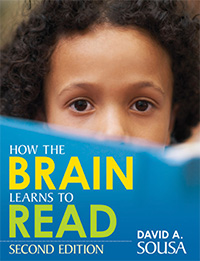
Best Sudoku iPhone Apps (promo)
Best book notes:
“Reading is the result of an elaborate process that involves decoding abstract symbols into sounds, then into words that generate meaning.”
“When aimed at the brain, computerized axial tomography (CAT) and magnetic resonance imaging (MRI) are very useful diagnostic tools that produce computer images of the brain’s internal structure. For example, they can detect tumors, malformations, and the damage caused by cerebral hemorrhages.”
“How quickly a child understands words may be closely related to whether the word can generate a clear mental image. A word like elephant generates a picture in the mind’s eye and thus can be more easily understood than an abstract word like justice.”
“Implication for Teaching and Learning: “Teachers should use concrete images when presenting an abstract concept to young learners.””
“In the early years, toddlers acquire most of their vocabulary words from their parents. Consequently, children who experience frequent adult-to-toddler conversations that contain a wide variety of words will build much larger vocabularies than those who experience infrequent conversations that contain fewer words. The incremental effect of this vocabulary difference grows exponentially and can lead to an enormous word gap during the child’s first three years.”
“the American Academy of Pediatrics recommends no media exposure prior to 2 years of age”
“Exposing children prior to 2 years of age to media may cause significant delays in cognitive processing and language development.”
“With more exposure to speech, the brain begins to recognize the beginnings of a hierarchy of language (Figure 1.3). Phonemes, the basic sounds, can be combined into morphemes, and through a set of conventions, morphemes can be combined into words. These words may accept prefixes, suffixes, and infixes (insertions), and may undergo a change of consonants or vowels. Words can be put together according to the rules of syntax (word order) to form phrases and sentences with meaning. The difference in meaning (semantics) between the sentences “The woman chased the dog” and “The dog chased the woman” results from a different word order, or syntax. Toddlers show evidence of their progression through the syntactic and semantic levels when simple statements, such as “Candy,” evolve to more complex ones, for example “Give me candy.” They also begin to recognize that shifting the words in sentences can change their meaning.”
“Figure 1.3 This diagram represents the levels of hierarchy in language and in language acquisition. Although the process at the beginning usually flows from the bottom to the top, recycling from the top to lower levels also occurs, as indicated by the arrows to the left. Through each step, the child’s vocabulary continues to grow rapidly.”
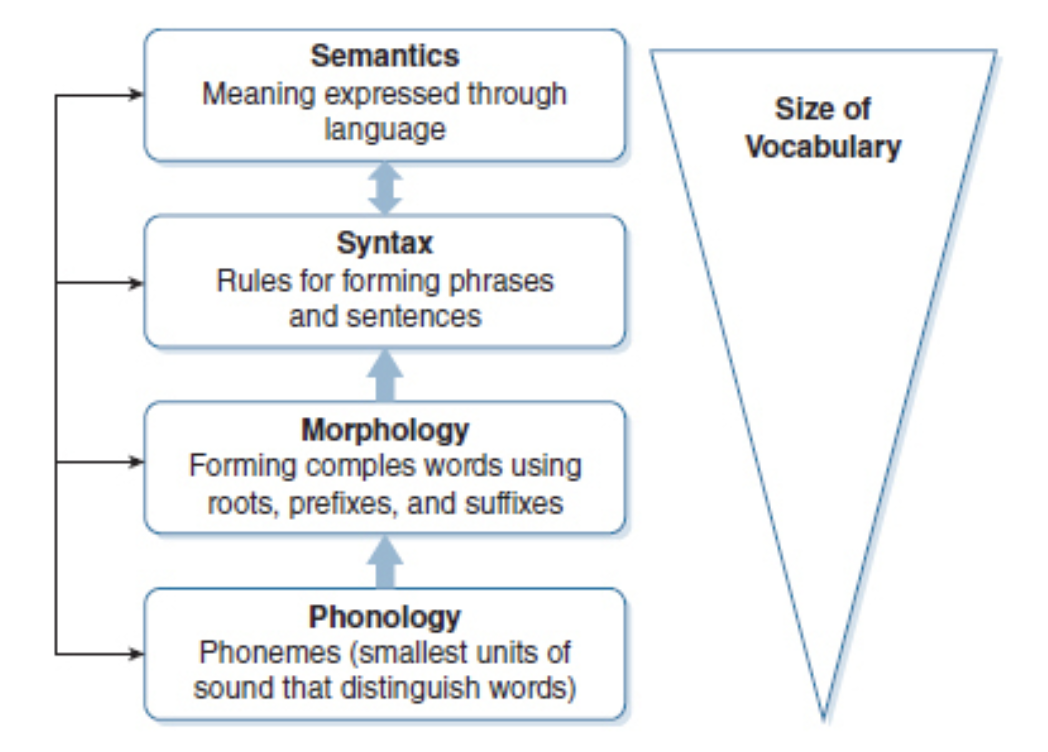
"Implication for Teaching and Learning: “Because of the brain’s apparent affinity for storing related words in the same cerebral region, teachers may want to purposefully group related words into lessons aimed at acquiring new vocabulary.”
“grouping, or chunking, individual words into phrases, processing time is decreased.”
“a three-phase model of how the brain acquires the ability to read (Frith, 1985).”
“Here is a brief summary of the three phases: 1) The first phase can be considered a pictorial stage, when the child’s brain photographs words and visually adjusts to the shape of the alphabet’s letters. 2) The second phase is the phonological stage, when the brain begins to decode the letters (graphemes) into sounds (phonemes). 3) The third phase is the orthographic stage, when the child is able to recognize words quickly and accurately. All of these phases activate several different brain circuits, which, over time and with practice, eventually converge in a specialized area of the left hemisphere. This area is now referred to in the scientific literature as the visual word form area.”
“To a large degree, learning to read is independent of intelligence.”
Speed reading practice (promo)
“Because the ability to read is strongly dependent on the word forms learned during this period, a child’s beginning reading will be more successful if most of the reading material contains words the child is already using.”
“Multiple Lexicons. We should mention here that there are several different types of lexicons in the brain of a proficient reader. The mental lexicon generally refers to the store of familiar words. But we also have an orthographic lexicon for visual recognition of letters, graphemes, and morphemes. For instance, the orthographic lexicon might deconstruct the word island into is + land. Our phonological lexicon, which stores how words are pronounced, would tell us that this word is pronounced eye-land. No doubt we also maintain a grammatical lexicon that contains the rules of plurals and sentence structure. Finally, to arrive at meaning, each word is associated with certain properties. For example, an island is an isolated piece of land, surrounded by water. This information is kept in a semantic lexicon. These various dictionaries communicate with each other to provide the information needed to make reading successful.”
“Learning to read starts with the awareness that speech is composed of individual sounds (phonemes) and a recognition that written spellings represent those sounds (the alphabetic principle).”
“Phonological awareness is the recognition that oral language can be divided into smaller components, such as sentences into words, words into syllables, and, ultimately, syllables into individual phonemes. This recognition includes identifying and manipulating onsets and rimes as well as having an awareness of alliteration, rhyming, syllabication, and intonation. Being phonologically aware means having an understanding of all these levels. In children, phonological awareness usually starts with initial sounds and rhyming, and a recognition that sentences can be segmented into words. Next comes segmenting words into syllables and blending syllables into words.”
“Phonemic awareness is a subdivision of phonological awareness and refers to the understanding that words are made up of individual sounds (phonemes) and that these sounds can be manipulated to create new words. It includes the ability to isolate a phoneme (first, middle, or last) from the rest of the word, to segment words into their component phonemes, and to delete a specific phoneme from a word.”
“Phonemic awareness is different from phonics. Phonemic awareness involves the auditory and oral manipulation of sounds.”
“Phonics is an instructional approach that builds on the alphabetic principle and associates letters and sounds with written symbols. To demonstrate phonics knowledge, a child tells the teacher which letter is needed to change cat to can.”
“To be able to read, the brain must memorize a set of arbitrary lines and squiggles (the alphabet). The brain does not yet know the system or logic of writing, but it begins to recognize patterns based on visual characteristics, such as curvature, orientation, and shape. For example, it notices that some symbols seem to be mirror images of each other (e.g., b and d, p and g), and that some are symmetrical (e.g., H, M, and O). It also detects that some symbols occur more often than others (e.g., a, e, r, and s), and that some letter combinations are more often at the end of the string (e.g., -ed, -ing, and -tion). This is what we referred to at the beginning of the chapter as Frith’s pictorial stage. Some of this visual letter/word recognition may occur before the formal teaching of reading. How many sight words are remembered will vary greatly among children.”
"Phonological awareness helps the beginning reader decipher printed words by linking them to the spoken words that the child already knows. This process is called decoding. It involves realizing that a printed word represents the spoken word through a written "
“sequence of graphemes that stand for phonemes, and then blending the phonemes to pronounce the word.”
“Decoding starts with learning the visual image of the letters of the alphabet and the basic sounds they represent.”
“Prealphabetic phase. In this phase, children remember words by connecting visual cues in the word (such as the two ls in bell or the curve at the end of dog) with the word’s meaning and pronunciation. There is no systematic letter-sound connection.”
“Partial alphabetic phase. In this phase, the child commits printed words to memory by connecting one or more printed letters with the corresponding sound(s) heard during pronunciation.”
“Full alphabetic phase. As reading progresses, phonemic awareness improves, and the reader moves into this phase. Here, the child remembers how to read a specific word by making accurate connections between the letters seen in the word and the phonemes used in the word’s pronunciation.”
“Consolidated alphabetic phase. In this phase, the beginning reader begins to notice multiletter sequences that are common to words stored in memory (such as the ending -ake in cake, make, and take, or -ent in bent, cent, and tent). By forming a chunk for each common sequence, word reading becomes faster and more efficient.”
“As reading practice continues, the neural systems are no longer decoding words letter by letter, but are becoming better at recognizing morphemes. Morphemes are the smallest word elements that can change a word’s meaning, such as the -ing that changes signal to signaling. They can stand on their own as a complete word (free morphemes) or exist as prefixes and suffixes (bound morphemes) that must be added to a root word. When readers understand morphemes, they can separate unfamiliar words into comprehensible parts. If the reader understands what hate means and also what -ful means, then the reader is likely to comprehend the meaning of hateful. This component of grammar that builds words out of pieces (morphemes) is called morphology.”
“There are two types of bound morphemes: 1. Inflectional morphemes. These are suffixes that provide information such as case (Tommy’s dog), number (dog/dogs), tense (he called), and person (she calls). 2. Derivational morphemes. These are affixes (prefixes and suffixes) that create new words by changing the meaning of the root words. Some derivational morphemes change the root word’s part of speech (attend is a verb, but add -ance and attendance becomes a noun). Others, like un- and re-, change the root word’s meaning but not the part of speech.”
“Morphology is an important component of our language, even to young brains. Research studies confirm that before they learn to read, children are more cognizant of morphology than phonology (Mann, 2000). This means they comprehend more easily that the inflectional morpheme -s in dogs represents the plural of dog than that the -s in yes represents a phoneme. They also understand more easily that the -er in bigger is a comparison to something that is already big than that the -er represents the second syllable in a word like power.”
“Young readers who are exposed to direct instruction on the morphological aspects of language become more capable readers than those who are not.”
“Comprehension of reading material occurs when readers are able to place the meaning of individual words into the structure and context of an entire sentence. Furthermore, the reader’s ability to remember the sentence’s structure (syntax) relies on working memory.”
“To understand how memory affects reading, we need a brief review of the brain’s memory components. As researchers gain greater insight into the brain’s memory processes, they have had to devise and revise terms that describe the various stages of memory. Neuroscientists now believe that we have two temporary memories that perform different tasks. It is a way of explaining how the brain deals briefly with some data, but can continue to process other data for extended periods of time. For now, short-term memory is used by cognitive neuroscientists to include the two stages of temporary memory: immediate memory and working memory (Gathercole, 2008).”
“Immediate Memory. Immediate memory is one of the two temporary memories and is represented in Figure 2.2 by a clipboard, a place where we put information briefly until we make a decision on how to dispose of it. Immediate memory operates subconsciously or consciously and holds data for up to about 30 seconds. (Note: The numbers used in this chapter are averages over time. There are always exceptions to these values as a result of human variations or pathologies.) The individual’s experiences determine its importance. If the information is of little or no importance within this time frame, it drops out of the memory system. For example, when you look up the telephone number of the local pizza parlor, you usually can remember it just long enough to make the call. After that, the number is of no further importance and drops out of immediate memory. The next time you call, you will have to look up the number again.”
“Working memory is the second temporary memory and the place where conscious, rather than subconscious, processing occurs. In Figure 2.2, working memory is shown as a work table, a place of limited capacity where we can build, take apart, or rework ideas for eventual storage somewhere else. When something is in working memory, it generally captures our focus and demands our attention. Scanning experiments show that most of working memory’s activity occurs in the frontal lobes, although other parts of the brain are often called into action (Gathercole, 2008; Goldberg, 2001).”
“Working memory can handle only a few items at one time. This functional capacity changes with age. Preschool infants can deal with about two items of information at once. Preadolescents can handle three to seven items, with an average of five. Through adolescence, further cognitive expansion occurs, and the capacity increases to a range of five to nine, with an average of seven. For most people, that number remains constant throughout life.”
“Figure 2.2 This diagram illustrates the theory of temporary and permanent memories. Information gathered from our senses lasts only a few seconds in immediate memory. Information that needs further processing moves to working memory where it usually endures for minutes or hours, but can be retained for days or longer, if necessary. The long-term storage sites (also called permanent memory) store information for years.”
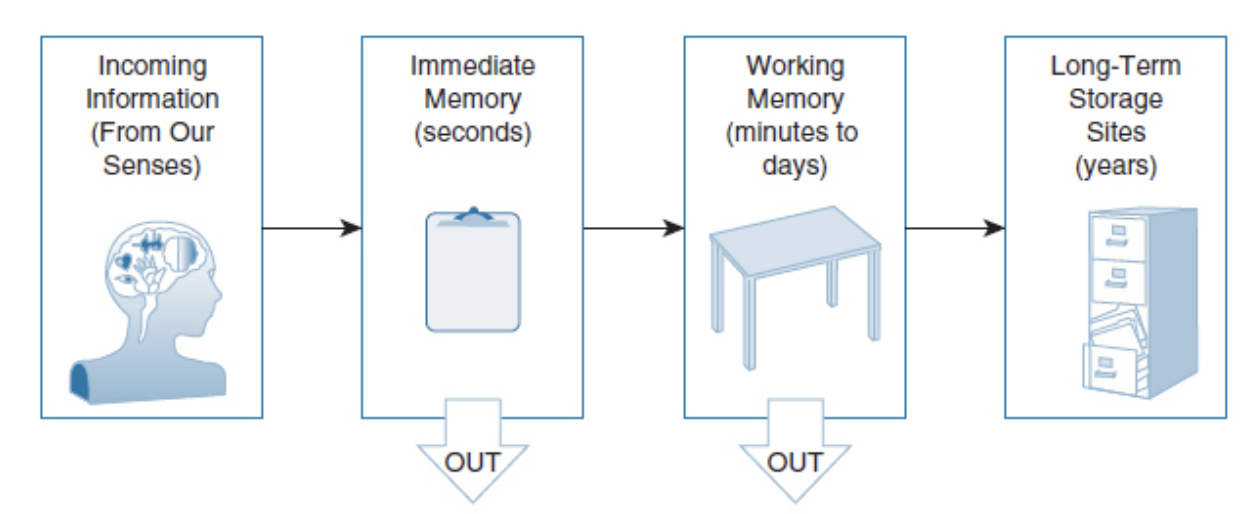
“Working memory is temporary and can deal with items for only a limited time. For preadolescents, it is more likely to be 5 to 10 minutes, and for adolescents and adults, 10 to 20 minutes. These are average times, and it is important to understand what the numbers mean. An adolescent (or adult) normally can process an item in working memory intently for 10 to 20 minutes before fatigue or boredom with that item occurs and the individual’s focus drifts to other items. For focus to continue, there must be some change in the way the individual is dealing with the item. As an example, the person may switch from thinking about it to physically using it, or making different connections to other learnings. If something else is not done with the item, it is likely to fade from working memory.”
“reading is a far more complicated skill involving a number of brain systems. When reading a word, the decoding process breaks the word into its segments, and while being retained in working memory, the phonemes are blended to form words that the reader can recognize. The ability to retain verbal bits of information is referred to as phonologic memory.”
“When reading sentences, the visual and memory systems of the brain must decode and then retain the words at the beginning of a sentence for a period of time while the reader’s eyes move to the end of the sentence. In a short sentence like “See the dog run,” that is no problem because the memory time-span requirement is minimal. However, reading complex sentences, such as “The boy ran down the street to tell his friend that the ice cream truck was just around the corner and would be here soon,” requires much more memory time. Furthermore, the brain must pay attention to syntax and context in order for the sentence to be accurately understood. Because of working memory’s limited capacity, beginning readers will have difficulty understanding long sentences or sentences with complex structure or syntax. They may be able to read the sentence aloud, but may not comprehend its meaning (Figure 2.3).”
“Figure 2.3 As a young beginning reader’s eye moves across the sentence, words that were at the beginning may fade from working memory. By the time the eyes gets toward the end of the sentence, the reader may not remember the previous words and thus cannot establish meaning.”
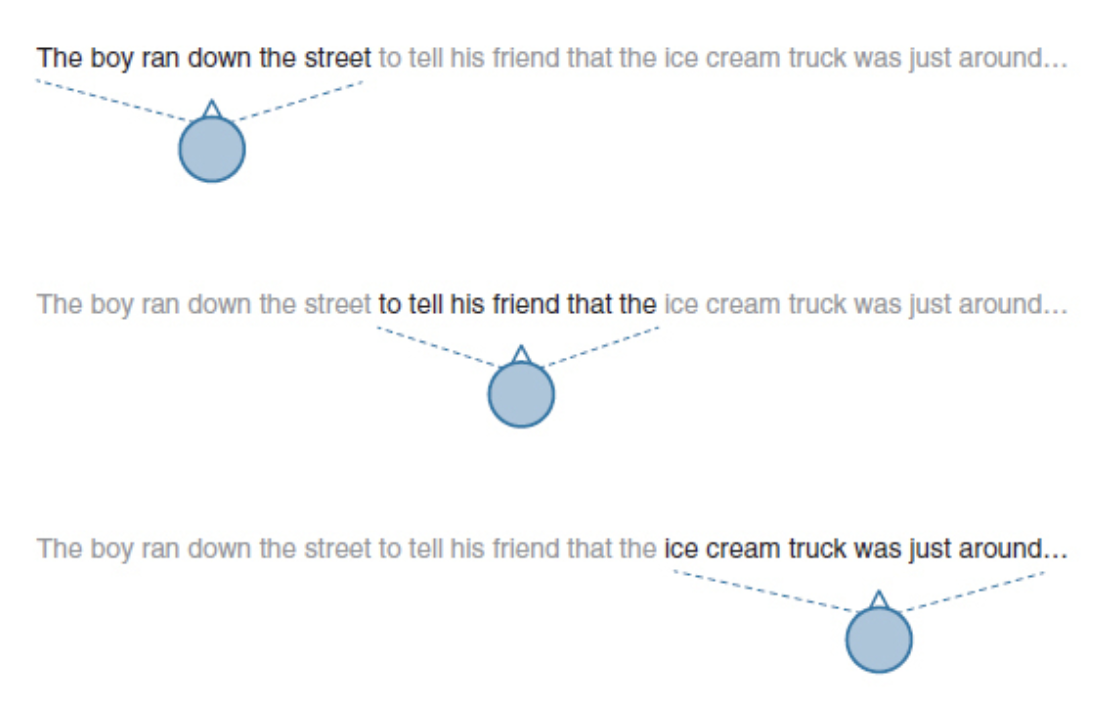
“A child’s ability to store words temporarily in working memory depends on several factors, such as age, experience, and language proficiency. But the code that readers of any age use to store written words and phrases is a phonological code. Consequently, phonological coding skills are crucial for using and developing the ability of working memory to store representations of written words. A reader with efficient phonological decoding skills will be able to quickly generate and retain phonetic representations of written words as well as preserve the words themselves and their sequence in the sentence. By developing these working memory skills, the reader with appropriate background knowledge can comprehend not only the sentence, but also the paragraph and the chapter. During reading, working memory helps comprehension in the following two ways: 1) Understanding complex structure. In complex sentences, such as “The woman who is getting into the blue car dropped her key,” working memory holds the decoded results of the first part of a sentence while the visual cortex processes the words and phrases in the rest of the sentence. Working memory then puts all the pieces together to establish the sentence’s meaning. 2) Preserving syntax (word order). Take the sentence “The driver of the blue car, not the red car, honked his horn.” Here, working memory preserves the word order so that the reader can process the sequence, recognize negation, and correctly identify who honked the horn.”
“Because working memory has a limited capacity, it cannot hold all the words of a long sentence. To deal with this limitation, working memory merges words within a clause to form a gist (the memory device known as chunking) that is then temporarily stored in place of the words. A gist essentially preserves a mental summary of the event described in what the individual just read, without the exact words (or number or pictures, for that matter). As reading continues, the brain adds new gists of clauses until the sentence is completed. Then a gist of the sentence is generated. Gists from other sentences in the paragraph are chunked to form a higher-level gist of the paragraph. Then, gists of paragraphs are chunked to form an even higher-level gist of the chapter, and eventually for the entire text. Table 2.3 shows how gists at one level combine to form gists of the next level.”
“Early reading makes heavy demands on both the processing and storage functions of a young working memory. Chunking the representations of word forms into gists is an efficient way of managing the competition for space and time in working memory. Gists take up less space and are retained while individual word forms are deleted. Sentence gists are then deleted when paragraph gists are formed, and so on. Clause gists endure for about 30 seconds; chapter gists can last for 15 minutes or more (SLC, 2000). However, these endurance times can be extended through oral rehearsal and with written summaries when the child is able to write. Gists can remain in memory networks for extended periods and serve as cues for recall. We have all had the experience where an unexpected stimulus (e.g., an old song or the odor of a perfume) brings back a memory or an event that may have occurred years ago. We cannot quite remember the details, but the “gist” is there (Reyna et al., 2011).”
“Table 2.3 Levels of Reading Comprehension Gists in Working Memory”

“Other factors affect the ability of working memory to retain or lose information during reading (Figure 2.4). New reading that the child finds interesting is likely to make it past immediate memory to working memory for conscious processing. And if the new reading activates material recently learned, long-term storage retrieves that information and moves it into working memory where it enhances the acquisition of the new learning. This process is called transfer and represents one of the most powerful principles of learning (Sousa, 2011a). Reading information can also leave working memory if either of the following occurs: 1) Too many minutes have elapsed since the information was last activated. For instance, just after reading the first sentence of a lengthy paragraph, the reader gets involved in a brief conversation not related to the reading with another child. When the reader returns to the text, the previously read material has faded, and the child must start again from the beginning. 2) Additional information is placed in working memory, and its capacity is exceeded. This can happen if the child is reading faster than he can comprehend, thus giving the brain insufficient time to form the necessary gists and then clear out the individual words. In this case, the words are removed from memory before the gist is generated, and comprehension suffers.”
Reading Speed Test (promo)
“Figure 2.4 Reading and memory interact in several ways. Reading that is interesting to the reader will pass through immediate memory into working memory for conscious processing. New reading may activate long-term storage to retrieve related gists already learned. Reading information can fall out of working memory by fading or by being displaced by additional information.”
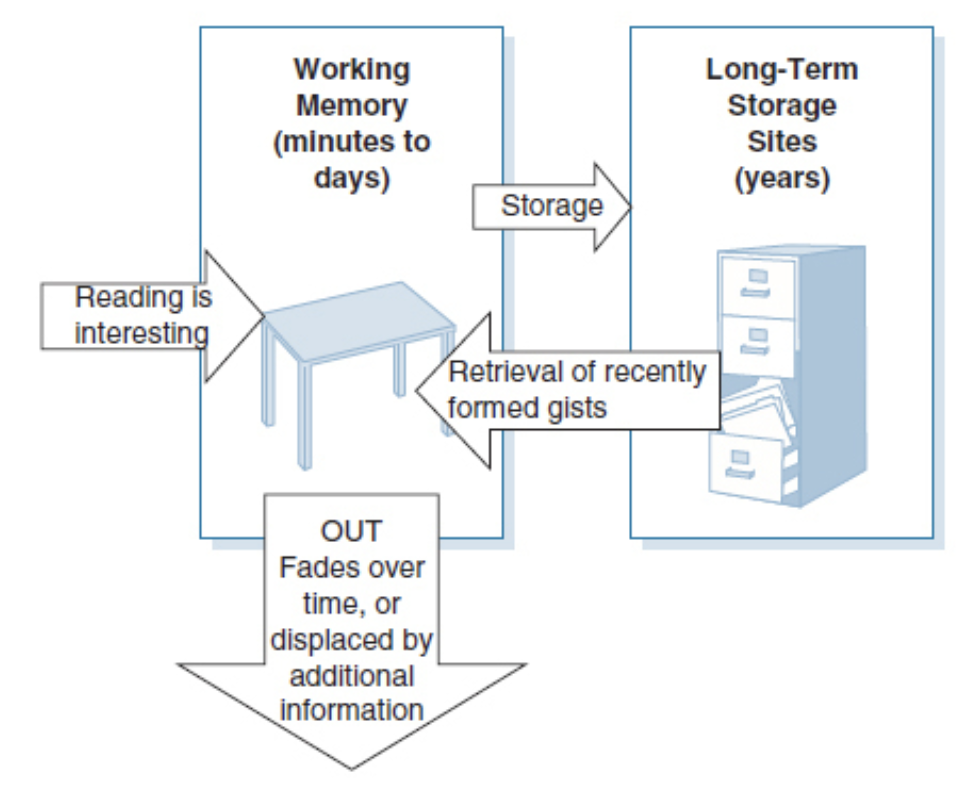
“As more demands are placed on working memory during reading, other difficulties may arise. A young child who is just learning to read using a book with advanced vocabulary words will have trouble with comprehension because so much memory capacity is being used trying to decode unfamiliar words. Research studies on the pace at which people read have offered further insights into how memory affects comprehension (e.g., Carretti, Borella, Cornoldi, & De Beni, 2009; Fedorenko, Gibson, & Rohde, 2006). For example, the studies found that readers spent more time reading the topic sentence of a paragraph. This may indicate that working memory is exerting more effort to generate and ensure the retaining of this gist because it is most useful in understanding the rest of the passage, and for creating the gist of the entire paragraph. The research studies also demonstrated, to no one’s surprise, that readers remembered best those ideas and concepts that were referenced repeatedly, as well as those that were linked through cause and effect (SLC, 2000). On the other hand, readers spent the least amount of time reading the details of a paragraph and, thus, had difficulty recalling them. They were able to recall, however, details related to a humorous or vivid event, probably because such events evoke emotion, a powerful memory enhancer.”
“Before learning to read, when a child sees a word, the left-hemisphere language centers do not show unusual activity (Table 2.4). Rather, regions in the right hemisphere activate, most likely processing the visual picture, or snapshot, of the word. This could represent the pictorial stage that we mentioned earlier in this chapter. During this prereading time, the child’s brain memorizes the snapshots from the shapes of the letters, similar to how it would recognize faces. For instance, we pointed out earlier that young children who spot and respond to a McDonald’s restaurant sign are probably reacting to the Golden Arches logo and a mental picture of the word McDonald’s, not to its phonemes. Nonetheless, the pattern-seeking capabilities of the brain are constantly at work, and there is evidence that this right-hemisphere region may visually differentiate strings of consonant letters (Maurer, Brem, Bucher, & Brandeis, 2005). At about the age of 6 or 7 years, the brain of a beginning reader responds more actively to printed words than to geometric shapes or meaningless letter strings - that is, nonwords (Maurer et al., 2006).”
“Visual Word Form Area. By the age of 8, the brain is aggressively recruiting areas in both hemispheres, especially in the visual recognition system, to deal with the challenge of increased reading. A clearly defined area of high activity emerges in the left hemisphere at the boundary of the occipital and temporal lobes (Parviainen, Helenius, Poskiparta, Niemi, & Salmelin, 2006; Yeatman, Rauschecker, & Wandell, 2013). That would place it slightly to the rear of the left ear. This region is officially called the left occipitotemporal area. However, scientists have suggested that it be called by a less technical term: the visual word form area, abbreviated as VWFA (Cohen et al., 2000). The term emphasizes its role in the visual analysis of letters and their shapes. With more reading practice, the VWFA attaches meaning directly to whole word forms, thereby allowing the reader to significantly increase fluency and comprehension (Glezer, Jiang, & Riesenhuber, 2009). Broca’s area, a specialized region for language located behind the left temple (see Chapter 1), is also significantly involved in this word analysis. Studies show that the activation in the VWFA and other language areas in the left-hemisphere area is in direct proportion to the child’s skill at phonemic awareness, or the ability to mentally manipulate the basic sounds of language (Turkeltaub, Gareau, Flowers, Zeffiro, & Eden, 2003). Once again, we see the impact of phonemic awareness on reading acquisition.”
“At this point, when the child’s brain now sees the word dog in print, the visual word form area records the three alphabetic symbols and activates the left-hemisphere language centers to provide and match the duh-awh-guh phonemes to their appropriate letters, duh = d, awh = o, and guh = g. This developing sound-to-letter relationship is the alphabetic principle in action. Eventually, a mental image of a furry animal is conceptualized in the mind’s eye, adding meaning to the symbolic representation of d-o-g. With more frequent exposure to the word dog, the VWFA will eventually attach the meaning to the word’s letter string, thereby increasing reading speed and comprehension.”
“Table 2.4 Comparison of Eye Movements of Novice and Skilled Readers (SOURCES: Häikiö et al. (2009); Rayner el al. (2001))”

“Pathways for Intermediate Readers. Learning to read enhances a child’s spoken language capabilities. Between 10 years of age and the beginning of adolescence, Broca’s and other language areas undergo significant modification in addition to the visual recognition system. Visual analysis occurs faster. With repeated encounters of the same word, the child’s brain makes a neural model-called a word form-and the child can read this word far more quickly. Just seeing it activates all the necessary components at once, mostly in the left hemisphere, without any conscious thought on the part of the reader. As more word forms collect in this cerebral region, reading becomes more fluent, and reading skill levels rise dramatically. Broca’s area now plays only a minor role in assisting this region. The more skilled the reader, the more quickly the VWFA responds to seeing a word-in less than 200 thousandths of a second (200 milliseconds), much faster than the blink of an eye (Dehaene, 2009).”
“more recent and extensive imaging research indicates that the process is much more complex. Letter analysis actually occurs in the VWFA, while several other word processing functions are operating in parallel. Perhaps a dozen or more neural sites are involved. The newer model helps explain how a skilled reader can acquire the visual images of words, extract their roots, determine syntax, and ultimately find meaning in just a fraction of a second. Brain regions must be operating simultaneously and constantly exchanging information with other sites.”
“The VWFA, however, generally responds only to written words and not to spoken words.”
“Reading Is Universal. Surprisingly, images of an adult reading brain are substantially the same regardless of the native language or culture of the individual in the scanning device. Even for Chinese and Japanese readers who use a pictorial script, or for those who read from right to left, the location of the VWFA in the left hemisphere is virtually identical.”
“To summarize, beginning readers rely on visual recognition information and use both Broca’s area and the developing visual word form area to slowly analyze each word. Intermediate and skilled readers, on the other hand, rely mainly on the visual word form area to process and direct information to interconnected sites, rapidly producing meaning from words, with only marginal help from Broca’s area when needed. As we shall see later on, children and adults with reading difficulties, including dyslexia, show patterns of brain activation when reading that are distinctly different from those described here.”
“When we encounter a word that we see frequently, we use a direct lexical or vocabulary-centered route that first identifies the letters (in the orthographic lexicon), next selects the word and its meaning (in the semantic lexicon), and then uses the phonological information (in the phonological lexicon) to retrieve its pronunciation. This direct route-letters to word/meaning to pronunciation-is used for most words, as long as they occur frequently and are stored in the reader’s various mental dictionaries (Figure 2.7).”
“Figure 2.7 This diagram illustrates the direct processing route taken when the reader sees a familiar written word, such as band. The brain recovers the meaning and identity of the word through the orthographic and semantic lexicons and then uses the phonological information to pronounce it.”
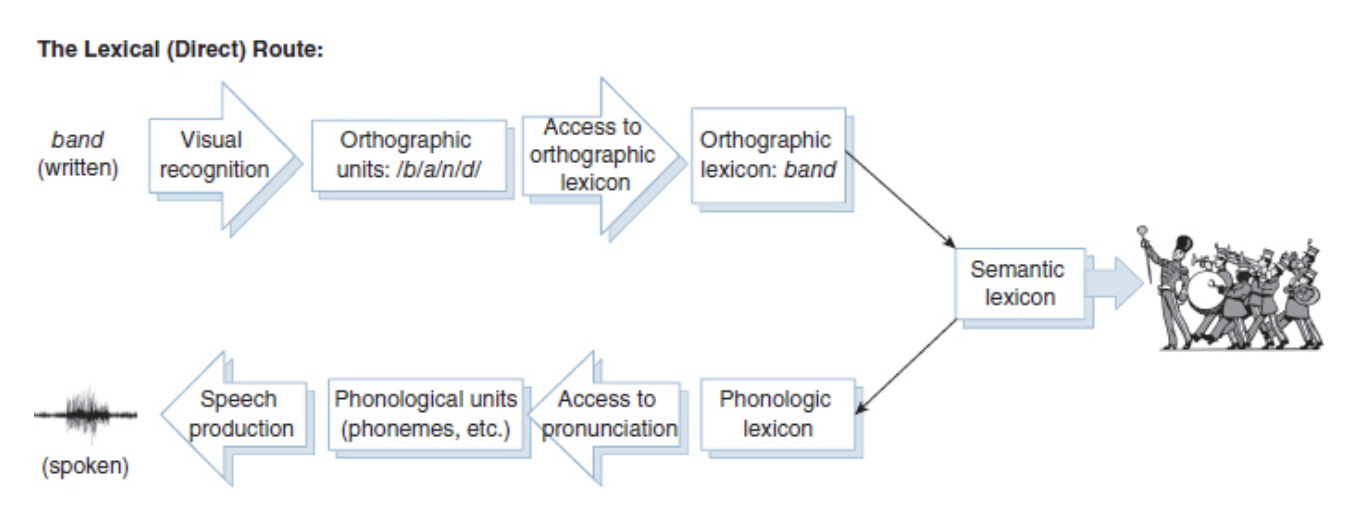
“However, when the word is novel or rare, we use a phonological route (Figure 2.8). On this route, the visual recognition system decodes the string of letters, then signals the language areas for the corresponding phonemes to help with pronunciation, and finally communicates with the frontal lobe in an attempt to find meaning in the sound pattern. Meaning may be difficult to find if the word is not in the mental lexicon, or is pronounced very differently than it is written, such as island, colonel, or Wednesday. This indirect route-letters to sounds to meaning—is helpful when we are learning new words.”
“Figure 2.8 This diagram illustrates the indirect route taken when the word is unfamiliar. The brain sends additional signals along multiple paths to determine if enough”
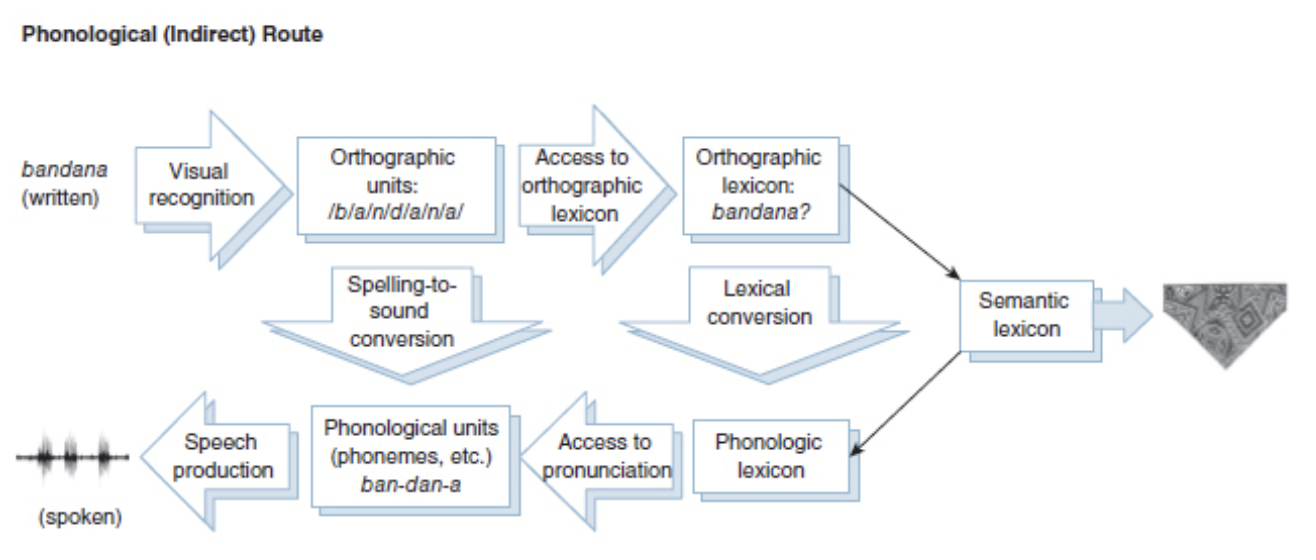
“Eye Movements During Reading. Only the central part of the eye, called the fovea, is the area on the retina of highest resolution. Consequently, when we read, our eyes make rapid movements across the page, called saccades, stopping for certain periods of time, called fixations. It is during these fixations of about 200 to 250 milliseconds that the eyes actually acquire information from the text. As you read this, your eyes are making four or five of those saccades per second in order to comprehend this text. Then the eyes take about 20 to 40 milliseconds to move to the next fixation point, a distance of about seven to nine letter spaces. This is a very small number but appears to represent the most information that our brain systems can process in one fixation. During this time, vision is suppressed, and no new information enters the processing system. Skilled readers also move their eyes backward about 10 to 15 percent of the time in order to reread material. These regressions are needed when the reader has difficulty comprehending the text (Rayner, 2009; Rayner, Foorman, Perfetti, Pesetsky, & Seidenberg, 2001).”
“Research studies on eye movements during reading lend further support to the notion that beginning and skilled readers are processing written information differently. Beginning readers fixate on every word in a text, and they often fixate on the same word several times. Their fixation points are only about three letter spaces apart, and their fixation periods run longer, from 300 to 400 milliseconds. Furthermore, up to 50 percent of their eye movements are regressions. These eye movements most likely indicate the difficulty the beginning reader is having encoding the text. The longer fixation time may also result from the slower process of word analysis that occurs in the brain’s visual word form area. Table 2.4 shows a comparison of the eye movements of novice and skilled readers. Research into how eye movements affect reading in adults has produced some interesting results (Häikiö, Bertram, Hyönä, & Niemi, 2009; Rayner, Slattery, & Blanger, 2010). It confirms that slow readers have a smaller perceptual span than fast readers. However, there was little difference in the slow and fast readers’ ability to identify the words they were reading. This finding supports earlier explanations that slow readers use more cerebral processing resources to comprehend the words they are fixated on than do fast readers.”
“It is evident that learning to read requires significant reorganization of the visual recognition and language processing areas of the brain. New neuronal connections and broader cerebral networks need to be established. Strengthening these connections and building disparate networks comes through repetition and practice. The more frequently these pathways are activated, the faster and more consolidated they become. Consequently, for most children, reading improves with practice. Experience in reading improves several components of the decoding and comprehension processes (Joseph, 2007; Rayner et al., 2001).”
“Turns low-frequency words into high-frequency words, improving the fluency of reading. Fluency involves developing rapid and automatic word-identification processes as well as bridging the gap between word recognition and comprehension.”
“Increases familiarity with the patterns of letters that form printed words, thereby improving spelling. This is referred to as the lexical-orthographic connection. It is not the same as the phonological-orthographic connection. Both contribute in their own way to support the brain’s ability to read words.”
“Skilled readers do not read each word individually, nor do their eyes move from word to word until they reach the end. Rather, they scan the text searching for patterns that will make the task of reading easier.”
“Vocabulary refers to the words we know that allow us to communicate effectively. Words that we use in our speech or that we recognize when listening comprise our oral vocabulary. Words we recognize or use in print comprise our reading vocabulary. Oral vocabulary becomes the basis for comprehension in reading.”
“Context clues to determine the meaning of words. Context clues are hints about the meaning of an unknown word that are provided by the words, phrases, and sentences that surround the word.”
“Comprehension is a complex interactive process that begins with identifying words by using knowledge outside the text, accessing word meaning in context, recognizing grammatical structures, drawing inferences, and self-monitoring to ensure that the text is making sense. When confronted with several meanings for a word in a sentence, the brain needs to select the one that makes sense in context. How this happens is the subject of much research. One possible mechanism, called the structure-building framework (Gernsbacher, Robertson, Palladino, & Werner, 2004), suggests that readers construct meaning by activating mental representations of concepts that are relevant to the text and blocking those that are irrelevant.”
“To learn to read is to light a fire; every syllable that is spelled out is a spark. —Victor Hugo (1802-1885), Les Misérables”
“Skilled reading requires an ability to retain verbal bits of information (phonemes) in working memory. Studies have shown distinct deficits in this phonologic memory among poor readers. The deficits more commonly involve serial tasks, such as holding a string of phonemes to make a word and a sequence of words to generate a sentence (Carretti, Borella, Cornoldi, & De Beni, 2009; Howes, Bigler, Burlingame, & Lawson, 2003).”
“Children with ADHD are often assumed to also have developmental reading problems. But that is not necessarily the case. ADHD and developmental dyslexia are separate disorders, although some brain regions may be affected by both.”
“Famous people with dyslexia include: Hans Christian Andersen (Author), Winston Churchill (Statesman), Tom Cruise (Actor), Leonardo da Vinci (Painter), Walt Disney (Producer), Albert Einstein (Physicist), Jay Leno (Comedian), Auguste Rodin (Sculptor), Steven Spielberg (Director), W. B. Yeats (Poet)”
“Because reading does not come naturally to the human brain, children learning to read have to put much effort into associating their spoken language with the alphabet and with word recognition. To do this successfully, phonemic awareness is essential. In light of recent research, educators should have second thoughts about reading programs that delay phonemic awareness or that treat it as an ancillary skill to be learned in context with general reading.”
“The young brain’s awareness of onsets, rimes, and syllables develops before an awareness of phonemes. Onsets are the initial consonants that change the meaning of a word; rimes are the vowel-consonant combinations that stay constant in a series. For example, in bend, lend, and send, the onsets are b, l, and s; the rime is -end. Note that the first step in Figure 6.1 is recognizing and generating rhymes. Rhyme generation can be used as an instructional strategy to develop explicit phonemic awareness skills by providing students with practice in manipulating the onset and the rime.”
“Fluency comes through repetition of words and sentences. Such repetition increases the chances that words and common phrases will be stored in long-term memory, allowing for faster word recognition during subsequent encounters.”
“Fluency comes through repetition of words and sentences. Such repetition increases the chances that words and common phrases will be stored in long-term memory, allowing for faster word recognition during subsequent encounters.”
“Preview, Review, and Predict: This step helps the brain’s frontal lobe search out some clues for determining the text’s main ideas. Prediction engages the brain’s creative networks and raises student interest.”
“Ask and Answer Questions: If we expect the brain to remember what it has learned, the information must make sense and have meaning. These questions prompt the student to search long-term memory to find already-stored information that can help with sense and meaning.”
“Summarize: By summarizing, the students are able to explain the text in their own words, thereby increasing the probability that it will make sense and have meaning.”
“Synthesize: This step helps students decide in which memory networks they will store the newly learned information. 1) Explain how the short passage fits in with the whole passage. 2) Explain how what you learned fits in with what you knew.”
“Reading aloud helps students of all ages gain confidence in their developing reading skills. This is especially important around the fourth grade where there is a large increase in vocabulary words with irregular pronunciations.”
“When you encounter an unknown word, try to guess its meaning by looking at the context. The sentences immediately before and after can give you good clues to determine meaning.”
“Each time you finish a paragraph, stop and try to summarize it in your own words.”
“learning to read and write are complex activities requiring at least seven levels of brain processing that must eventually be integrated: 1) Phonological-knowing the sound system of language, phonemic awareness, and sound-letter correspondences 2) Graphic—visually perceiving letters and symbols 3) Lexical-recognizing words and their component parts, such as prefixes and suffixes 4) Syntactic-understanding rules of grammar and discourse 5) Semantic-comprehending meaning and detecting thematic structures 6) Communicative expressing purposes and intentions 7) Cultural-communicating shared beliefs and knowledge”


No comments:
Post a Comment